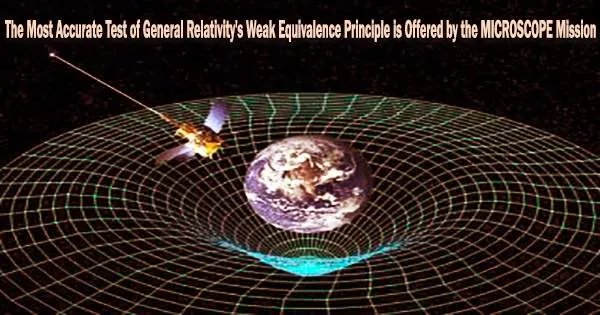The MICROSCOPE mission, also known as the Micro-Satellite à Traînée Compensée pour l’Observation du Principe d’Equivalence, was a satellite mission designed to test the weak equivalence principle (WEP) of general relativity. The WEP states that the trajectory of a freely falling object is independent of its composition or structure.
In new studies published in Physical Review Letters and a special issue of Classical and Quantum Gravity on 14th September 2022, a team of researchers present the most precise test yet of the Weak Equivalence Principle, a key component of the theory of general relativity. The study details the MICROSCOPE mission’s final findings, which tested the idea by determining the accelerations of falling items in an Earth-orbiting satellite.
The researchers determined that there were no breaches of the Weak Equivalence Principle or departures from the present understanding of general relativity at the level where the accelerations of pairs of objects diverged by more than one part in 1015.
“We have new and much better constraints for any future theory because these theories must not violate the equivalence principle at this level,” says Gilles Métris, a scientist at Côte d’Azur Observatory and member of the MICROSCOPE team.
The MICROSCOPE mission was launched in April 2016 and operated until October 2021, when it was decommissioned. It used a pair of ultra-precise, free-falling test masses to measure the acceleration of gravity with unprecedented accuracy.
The theory of general relativity, published by Albert Einstein in 1915, describes how gravity works and relates to time and space. However, because it does not take into account the observations of quantum phenomena, scientists search for exceptions to the theory with increasing levels of accuracy and in different contexts.
We have new and much better constraints for any future theory because these theories must not violate the equivalence principle at this level.
Gilles Métris
These infractions would point to fresh interactions or forces that might link quantum physics with relativity. Testing the Weak Equivalence Principle (WEP) is one way to look for potential expansions to general relativity.
According to the WEP, objects in a gravitational field fall in the same way when no other forces are acting on them, even if they have different masses or compositions. To test the principle, the MICROSCOPE team designed their experiment to measure the Eötvös ratio which relates the accelerations of two free-falling objects to extremely high precision.
The experiment would measure the acceleration of each object and find a breach of the WEP if one object’s acceleration varied from the other by more than one part in 1015. The researchers used the MICROSCOPE satellite to observe the accelerations of test masses made of platinum and titanium alloys in order to calculate the Eötvös ratio.
Pairs of test masses were held in place by electrostatic forces, and the experimental device monitored these forces for any potential variations that would signify variations in the accelerations of the objects.
Finding techniques to test the device on Earth to ensure that it will function as intended in space presented one of the experiment’s biggest challenges.
“The difficulty is that the instrument we launch cannot operate on the ground,” says Manuel Rodrigues, a scientist at the French aerospace lab ONERA and member of the MICROSCOPE team. “So it’s a kind of blind test.”
Once the instrument was ready, the team launched it in 2016. After the mission’s conclusion in 2018, they continued to examine the data, taking into account malfunctions and systematic uncertainties and announced the preliminary results in 2017. The WEP was ultimately upheld, placing the strictest limitations on the principle yet.
The team’s work lays the path for satellite research that will test the WEP even more precisely. Their research includes recommendations for methods to enhance the experimental setting, such as minimizing satellite coating crackles that hampered acceleration measurements and swapping out wires for contactless devices.
A satellite experiment that implements these upgrades should be able to measure potential violations of the WEP at the level of one part in 1017, the researchers say. But the MICROSCOPE results will likely remain the most precise constraints on the WEP for a while.
“For at least one decade or maybe two, we don’t see any improvement with a space satellite experiment,” Rodrigues says.
Overall, the MICROSCOPE mission was successful in demonstrating the validity of the WEP and general relativity to a high level of precision. It also provided valuable insights into the fundamental nature of gravity and opened the door to further studies of the fundamental laws of physics.





